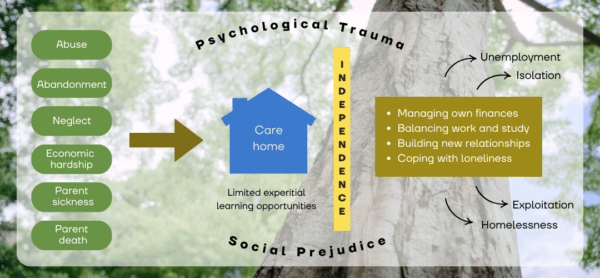Children We Support
Children We Support

Care Homes in Japan
Children’s care homes are facilities that provide shelter and care for children aged one to eighteen who cannot live with their parents or whose families are unable to raise them adequately. The reasons for admission vary and include the loss of parents, divorce, illness, or economic hardship. Recently, there has been a concerning rise in cases where children enter care due to abuse. Reports indicate 71.7% of the children in care homes have experienced abuse in the past.
A recent report shows that there are over 610 care homes in Japan housing approximately 23,043 children. The average age of children in care is 12 years old, and over half of them entered institutional care before the age of 6.

Life in Care Homes
Care homes in Japan are gradually shifting from large, communal living facilities to smaller, family-like units to simulate a household. In larger facilities, children are often grouped by gender or age, though some groups include children of various ages and genders. Siblings are not always placed in the same care home and may even be assigned to different groups within the same facility.
Children attend local schools and participate in hobbies, sports, and other leisure activities. They also engage in events organized by care homes or local children’s groups. For children whose families can visit, weekend visits are arranged, and some return home during holidays.
 |
 |
Challenges Faced by the Children
Social Prejudice
Public understanding of care homes and the circumstances of the children living there remains limited. Many people harbor misconceptions, such as believing that all children in care are “problematic” or “anti-social.” Social systems often fail to accommodate their circumstances, resulting in difficulties such as renting apartments, obtaining phone contracts, and facing discrimination at school or work. This stigma leads many children and adults to hide the fact that they live or have lived in care homes.
Psychological Trauma
Children in care homes often bear the scars of their past, suffering from psychological trauma that impacts their development and future. These challenges often persist long after they leave care homes, hindering their ability to thrive independently.
|
|
|
|
|
|
|
|
|
Transition to Independence
In principle, children leave the care homes and live independently at 18, as they graduate from high school, and begin to manage every aspect of their lives. Despite some preparation during high school, the transition from the structured environment of a care home to an independent life is abrupt and overwhelming. Young adults face new challenges, including managing finances, balancing work and study, building new relationships, and coping with social prejudice and loneliness.
As one care worker noted, turning 18 and leaving the care home may feel like an end to some of us, but to the children, this is when real learning, development, and journey towards their dream actually starts.
Limited opportunities and the Future
Economic constraints mean most young adults leaving care homes opt to work instead of pursuing higher education. In 2024, approximately 60% of high school graduates in Japan advance to higher education, only 20% of care home graduates do the same. Even those who pursue higher education often struggle to balance work and study, leading some to drop out.
Without sufficient preparation, adequate social support, and while still suffering from psychological trauma, many young adults face significant challenges in their independent lives. Some find themselves in precarious situations, unable to manage the demands of adulthood.
Dealing with so many unforeseen issues that they never had an opportunity to prepare for and adjusting to a whole new life all on their own requires tremendous effort and mental strength. Unfortunately, we have seen a few children who could not cope. While care homes have started implementing support systems for young adults, such as providing essential supplies and consultations, these initiatives remain reliant on personal connections between care workers and the children. With a severe shortage of care workers, systemic improvements are still needed to ensure all young adults receive equal and adequate support.
From our 10 years of experience working with this community, we have observed several unfortunate outcomes for young adults who struggle to adapt to independent living, including:
- Unemployment
- Isolation
- Exploitation
- Homelessness
 Lack of self-affirmation
Lack of self-affirmation


